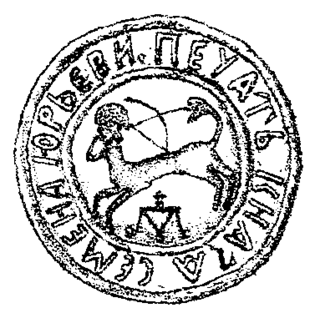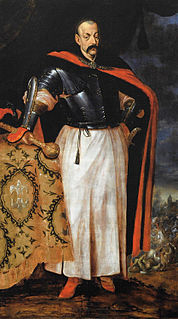 W
WHrehory Chodkiewicz was a Ruthenian noble and military officer of the Grand Duchy of Lithuania. He was a son of Aleksander, brother of Hieronim and Yurii, and uncle of Jan Hieronimowicz Chodkiewicz. He commanded the Lithuanian army during the later part of the Livonian War after he had become the Great Lithuanian Hetman in 1566.
 W
WJan Karol Chodkiewicz was a military commander of the Polish–Lithuanian Commonwealth army who was from 1601 Field Hetman of Lithuania, and from 1605 Grand Hetman of Lithuania, and was one of the most prominent noblemen and military commanders of the Polish–Lithuanian Commonwealth of his era. His coat of arms was Chodkiewicz, as was his family name.
 W
WPrince Semyon Yurievich of Halshany was a noble from the Olshanski family in the Grand Duchy of Lithuania.
 W
WStanislovas Kęsgaila Jonaitis was a Lithuanian nobleman, son of Jonas Kęsgaila from the Kęsgailos family. Stanislovas Kęsgaila was the Elder of Samogitia (1486–1522), Grand Hetman of Lithuania (1501–1502), castellan of Trakai (1499–1522) and Vilnius (1522–1526).
 W
WJanusz Kiszka was a Polish politician and magnate in the 17th century Polish–Lithuanian Commonwealth. Last of the Kiszka family. Royal Rotmistrz, starosta of Parnawa from 1610, Voivode of Polock since 1621, Field Lithuanian Hetman since 1635, Great Lithuanian Hetman since 1646.
 W
WStanisław Piotrowicz Kiszka was a noble, diplomat and military commander from the Grand Duchy of Lithuania. He became the progenitor of the prominent Kiszka family. He was sent on frequent diplomatic missions to the Grand Duchy of Moscow and Kingdom of Poland. He attempted to negotiate peace during the Muscovite–Lithuanian Wars and supported a closer union between Poland and Lithuania. During the Second Muscovite–Lithuanian War (1500–03), he successfully defended Smolensk and became Great Hetman until Konstanty Ostrogski escaped Russian captivity in 1507. Kiszka helped to subdue the Glinski rebellion in 1508. Shortly before his death, Kiszka also became Grand Marshal of Lithuania.
 W
WSzymon Marcin Kossakowski was a Polish–Lithuanian nobleman (szlachcic), and one of the leaders of the Targowica Confederation. In 1793, he became the last Great Hetman of Lithuania.
 W
WPrince Michał Józef Masalski was a Polish-Lithuanian nobleman (szlachcic).
 W
WGrzegorz Antoni Ogiński was a Polish-Lithuanian Hetman and governor-general of the Duchy of Samogitia from 1698. He was the fourth and youngest son of Jan Jacek Ogiński, also a hetman.
 W
WPrince Michał Kazimierz Ogiński of Oginiec was a Polish nobleman, a political office holder and a military commander in the Grand Duchy of Lithuania, as well as a noted musician and composer.
 W
WKonstanty Iwanowicz Ostrogski was a prince and magnate of the Grand Duchy of Lithuania and later a Grand Hetman of Lithuania from 11 September 1497 until his death.
 W
WMichał Kazimierz Pac of the Gozdawa Coat of Arms, was a Polish-Lithuanian nobleman and a member of the Pac family. He was a son of Piotr Pac ; and a cousin of Krzysztof Zygmunt Pac, the Chancellor of Lithuania.
 W
WLudwik Konstanty Pociej (1664-1730) was a Polish nobleman, podkomorzy of Brest, podskarbi, castelan and voivode of Vilnius, Great and Field Hetman of Lithuania.
 W
WPrince Janusz Radziwiłł, also known as Janusz the Second or Janusz the Younger was a noble and magnate in the Polish–Lithuanian Commonwealth. Throughout his life he occupied a number of posts in the state administration, including that of Court Chamberlain of Lithuania, Field Hetman of Lithuania and Grand Hetman of Lithuania. He was also a voivode of Vilna Voivodeship, as well as a starost of Samogitia, Kamieniec, Kazimierz and Sejwy. He was a protector of the Protestant religion in Lithuania and sponsor of many Protestant schools and churches.
 W
WJerzy Radziwiłł, nicknamed "Herkules", was a Polish–Lithuanian nobleman.
 W
WPrince Krzysztof Radziwiłł was a Polish–Lithuanian noble (szlachcic), and a notable magnate, politician and military commander of his epoch. Sometimes referred to as Krzysztof Radziwiłł II, to distinguish him from his father, Krzysztof Mikołaj 'Piorun' Radziwłł.
 W
WPrince Krzysztof Mikołaj Radziwiłł, nicknamed "Piorun" was a Reichsfürst of the Holy Roman Empire and a member of the nobility of the Polish–Lithuanian Commonwealth.
 W
WPrince Michał Kazimierz Radziwiłł was a Polish–Lithuanian noble. A member of the aristocratic Radziwiłł family, he was frequently referred to by his idiolect Rybeńko (Рыбанька), to distinguish him from the other Michał Kazimierz Radziwiłł. Ordynat of Niasviž and Olyka, owner of Biržai, Dubingiai, Slutsk, Kopyła and Shumsk.
 W
WMikołaj Radziwiłł, nicknamed The Red, also known as Mikołaj Radziwiłł the Sixth, was a Lithuanian nobleman, Count Palatine of Vilnius, Grand Chancellor of Lithuania, and Grand Lithuanian Hetman in the Grand Duchy of Lithuania and later in Polish–Lithuanian Commonwealth. Together with his cousin Mikołaj "the Black" Radziwiłł and the Radziwiłł family were granted title and position as Reichsfürst Prince of the Holy Roman Empire.
 W
WJan Kazimierz Sapieha the Elder (?–1730) was a Grand Hetman of Lithuania since 1708 to 1709.
 W
WJan Kazimierz Sapieha the Younger (1637–1720) was a Grand Hetman of Lithuania commencing in 1682. He held the title of a Duke starting in 1700. In 1681 he became Field Hetman of Lithuania, the following year he also became the voivode of Vilnius.
 W
WLew Sapieha was a nobleman and statesman of the Polish–Lithuanian Commonwealth. He became Great Secretary of the Grand Duchy of Lithuania in 1580, Great Clerk of the Grand Duchy in 1581, Crown Chancellor in 1585, Grand Chancellor from 1589 until 1623, Voivode of Vilnius in 1621, Great Lithuanian Hetman in 1623 and governor of Slonim, Brest and Mogilev.
 W
WPaul John Sapieha (1609–1665) was a Polish–Lithuanian nobleman (szlachcic).
 W
WPrince Michał Serwacy Wiśniowiecki (1680–1744) was a Polish-Lithuanian nobleman, magnate, politician, diplomat, general, a successful military commander and the last male representative of the Wiśniowiecki family.